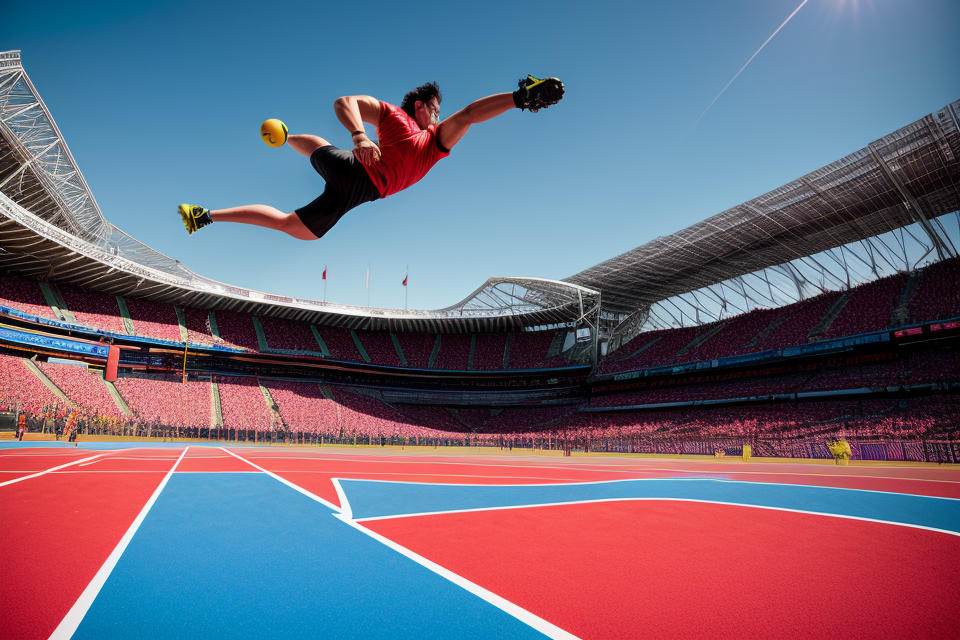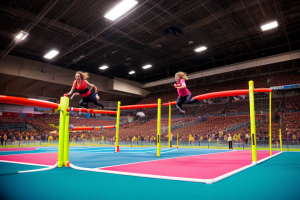
Agility sports and games are a group of activities that require participants to navigate through a series of obstacles while showcasing their speed, coordination, and reaction time. These sports are designed to test the athlete’s ability to change direction quickly and efficiently, making them an excellent way to improve physical fitness and mental agility. From parkour to dodgeball, there are a variety of agility sports and games that cater to different interests and skill levels. In this article, we will explore some of the most popular agility sports and games, and provide a brief overview of what makes them so exciting and challenging. Whether you’re a seasoned athlete or just looking for a new way to stay active, there’s an agility sport or game out there for you. So, let’s get started and discover the thrilling world of agility sports and games!
Agility sports and games are those that require quick movements and reactions. Examples include sports such as track and field events like hurdles and relay races, as well as sports like gymnastics, martial arts, and dance. Games that involve agility include obstacle courses, parkour, and video games that require fast reflexes and coordination. Additionally, dog agility competitions are a popular form of agility competition, where dogs and their handlers navigate through a course of obstacles and challenges. These sports and games require strength, speed, and coordination, and can be enjoyed by people of all ages and skill levels.
Definition of Agility Sports and Games
Types of Agility Sports and Games
Obstacle Course Racing
Obstacle course racing (OCR) is a type of agility sport that involves navigating through a series of obstacles, such as walls, hurdles, and mud pits, to reach the finish line. Participants can compete in different distances, such as short, medium, or long, depending on their fitness level and preferences. OCR is a challenging and exciting sport that requires strength, endurance, and agility.
Sprint Obstacle Course Racing
Sprint OCR is a shorter version of traditional OCR, with shorter distances and fewer obstacles. It is designed for participants who want to test their speed and agility in a shorter and more intense race. Sprint OCR races are usually held on a track or a grassy field, and the obstacles are designed to test the participant’s speed and agility.
Endurance Obstacle Course Racing
Endurance OCR is a longer version of traditional OCR, with longer distances and more obstacles. It is designed for participants who want to test their endurance and stamina in a longer and more challenging race. Endurance OCR races are usually held in natural environments, such as forests or mountains, and the obstacles are designed to test the participant’s endurance and mental toughness.
Trail Running
Trail running is a type of agility sport that involves running on trails and paths in natural environments, such as forests, mountains, or deserts. Trail running is a challenging and exciting sport that requires strength, endurance, and agility. Participants can compete in different distances, such as short, medium, or long, depending on their fitness level and preferences.
Parkour
Parkour is a type of agility sport that involves moving through obstacle courses by jumping, climbing, and running. Participants use their strength, agility, and endurance to overcome obstacles and reach the finish line. Parkour is a challenging and exciting sport that requires strength, endurance, and mental toughness.
Ninja Warrior
Ninja Warrior is a type of agility game that involves navigating through obstacle courses inspired by Japanese ninja culture. Participants use their strength, agility, and endurance to overcome obstacles, such as walls, bars, and ropes, and reach the finish line. Ninja Warrior is a challenging and exciting game that requires strength, endurance, and mental toughness.
Agility Drills and Exercises
Agility drills and exercises are designed to improve a person’s agility, balance, and coordination. These drills and exercises can be done in various settings, such as on a field or in a gym. Some examples of agility drills and exercises include ladder drills, cone drills, and shuttle runs.
Speed Agility Cone Drill
The speed agility cone drill is a type of agility drill that involves moving through a series of cones in a specific pattern. The drill is designed to improve a person’s speed, agility, and coordination. Participants start at one cone and move through a series of cones in a specific pattern, such as a zigzag or a figure eight.
Pro Agility Shuttle Drill
The pro agility shuttle drill is a type of agility drill that involves moving through a series of cones in a specific pattern while touching each cone with both feet. The drill is designed to improve a person’s speed, agility, and coordination. Participants start at one cone and move through a series of cones in a specific pattern, such as a zigzag or a figure eight, while touching each cone with both feet.
Agility Ladder Drill
The agility ladder drill is a type of agility drill that involves moving through a ladder of cones in a specific pattern. The drill is designed to improve a person’s speed, agility, and coordination. Participants start at one end of the ladder and move through a series of cones in a specific pattern, such as a zigzag or a figure eight.
Benefits of Participating in Agility Sports and Games
Physical Benefits
Improved Strength and Endurance
Participating in agility sports and games can help improve your overall physical fitness by increasing your strength and endurance. These activities often involve quick movements, jumps, and turns, which can help build muscle mass and improve cardiovascular health. Regular practice can also enhance your muscle tone and overall physical appearance.
Enhanced Coordination and Balance
Agility sports and games require quick reflexes, sharp instincts, and precise movements. By participating in these activities, you can improve your coordination and balance, which can benefit your overall physical abilities. You may find that you have better control over your body, making it easier to perform everyday tasks and activities.
Reduced Risk of Injury
Agility sports and games can also help reduce your risk of injury by improving your body’s overall physical capabilities. When you participate in activities that require quick movements and changes in direction, you are training your body to respond more quickly and effectively to different situations. This can help prevent injuries caused by sudden movements or changes in direction, as your body is better equipped to handle these situations. Additionally, regular practice can help build stronger muscles and joints, which can also reduce your risk of injury.
Mental Benefits
Increased Confidence and Self-Esteem
Engaging in agility sports and games can boost one’s confidence and self-esteem. By pushing themselves to conquer physical challenges, individuals develop a sense of accomplishment and pride in their abilities. As they improve their skills and overcome obstacles, their self-confidence grows, which can positively impact other areas of their lives.
Enhanced Problem-Solving Skills
Agility sports and games often require quick thinking and adaptability. Participants must be able to problem-solve on their feet, making split-second decisions to navigate through obstacles or avoid opponents. This type of mental stimulation can enhance overall problem-solving skills, improving cognitive function and critical thinking abilities.
Improved Focus and Concentration
The fast-paced nature of agility sports and games demands sharp focus and concentration. Successful completion of these activities requires sustained attention to the task at hand, while also being aware of one’s surroundings and potential threats. This intense mental effort can improve overall focus and concentration in daily life, enhancing productivity and performance in various tasks.
Safety Tips for Participating in Agility Sports and Games
Warm-Up and Stretching
Before engaging in any agility sports or games, it is important to properly warm up and stretch to prevent injury.
Pre-Workout Stretching
Pre-workout stretching involves dynamic stretches that prepare the muscles for physical activity. These stretches should be performed slowly and with control to increase blood flow and reduce the risk of injury. Examples of pre-workout stretches include:
- Leg swings
- Arm circles
- High knees
- Butt kicks
- Lunges
Dynamic Stretching
Dynamic stretching is a type of stretching that involves movement, such as walking or jumping, to increase blood flow and warm up the muscles. These stretches should be performed for 10-15 seconds and repeated for 2-3 sets. Examples of dynamic stretches include:
- Jumping jacks
- Hip circles
It is important to note that static stretching, such as holding a stretch for a prolonged period of time, should be avoided before physical activity as it can decrease muscle power and affect performance. Instead, dynamic stretching should be performed to properly warm up the muscles and reduce the risk of injury.
Proper Technique and Form
Proper technique and form are essential for participating in agility sports and games. Without proper technique, individuals risk injury and may not perform to their best ability. To prevent injury and improve performance, it is important to focus on proper form while participating in agility sports and games.
Using Proper Form to Prevent Injury
Proper form is critical to preventing injury in agility sports and games. When individuals do not use proper form, they risk overexerting themselves and causing injury. For example, when running, it is important to keep the feet under the hips and to use a natural stride. This helps to prevent injuries such as shin splints and stress fractures.
In addition, it is important to warm up before participating in agility sports and games. Warming up helps to increase blood flow to the muscles and can help prevent injury. Warming up should include dynamic stretches, such as lunges and leg swings, as well as light cardio activity, such as jogging or jumping jacks.
Focusing on Proper Technique to Improve Performance
Proper technique is also essential for improving performance in agility sports and games. When individuals use proper technique, they are able to perform at their best and improve their overall performance. For example, when participating in track and field events, it is important to use proper technique when starting, such as keeping the arms straight and the feet planted firmly on the ground.
In addition, it is important to focus on proper technique when participating in agility drills. Agility drills, such as ladder drills and cone drills, help to improve footwork and coordination. However, it is important to use proper technique when participating in these drills to prevent injury and improve performance.
Overall, proper technique and form are essential for participating in agility sports and games. By using proper form, individuals can prevent injury and improve their overall performance.
Equipment and Gear
Participating in agility sports and games requires the right equipment and gear to ensure safety and prevent injuries. Here are some essential pieces of equipment that one should have before participating in any agility sport or game:
Choosing the Right Shoes
The shoes you wear can make a significant difference in your performance and safety while participating in agility sports and games. It is important to choose shoes that provide good traction, support, and stability. For example, soccer players should wear cleats that fit well and provide support for their feet, while track and field athletes should wear shoes with spikes for better traction on the track.
Wearing Proper Clothing
Wearing proper clothing is also essential when participating in agility sports and games. The type of clothing you wear will depend on the sport or game you are participating in. For example, basketball players should wear shorts and a t-shirt or jersey, while soccer players should wear shorts and socks that cover their shins.
Using Protective Gear
In addition to wearing proper clothing, it is also important to use protective gear when participating in agility sports and games. Protective gear can help prevent injuries and accidents that may occur during play. For example, hockey players should wear helmets, face masks, and pads to protect their heads, necks, and bodies from impacts and collisions. Similarly, football players should wear helmets, shoulder pads, and other padding to protect their bodies from impacts and tackles.
Overall, it is important to invest in the right equipment and gear to ensure safety and prevent injuries when participating in agility sports and games. By choosing the right shoes, wearing proper clothing, and using protective gear, one can enjoy the benefits of agility sports and games without compromising their safety.
Encouragement to Try Agility Sports and Games
Fun and Exciting Ways to Stay Active
Trying agility sports and games is a great way to stay active and have fun at the same time. Whether you’re a seasoned athlete or just starting out, there’s an agility sport or game for everyone. From parkour to obstacle course racing, the options are endless.
Benefits of Participating in Agility Sports and Games
Participating in agility sports and games has many benefits, including improved physical fitness, increased coordination and balance, and enhanced mental focus and concentration. It’s also a great way to meet new people and make friends, as many agility sports and games are team-based.
Encouragement to Get Started Today!
Don’t wait any longer to try agility sports and games. Get started today and see the benefits for yourself. Whether you’re looking to improve your physical fitness, mental focus, or just want to have fun, agility sports and games are the perfect way to achieve your goals. So, what are you waiting for? Get started today and see how far it can take you!
FAQs
1. What are agility sports?
Agility sports are activities that require quick reflexes, coordination, and balance. They often involve moving through obstacle courses or performing specific movements in response to stimuli. These sports can be played individually or as a team and can be found in both recreational and competitive settings.
2. What are some examples of agility sports?
There are many different agility sports and games, including:
* Obstacle course racing: This involves running through a course filled with various obstacles, such as walls, mud pits, and barbed wire.
* Parkour: A form of training that involves moving through urban environments by jumping, climbing, and running.
* Sprint hurdles: This is a track and field event where athletes must run through a series of obstacles, such as hurdles, while maintaining their speed and agility.
* Agility dog competitions: These competitions involve dogs running through a course that includes various obstacles, such as jumps, tunnels, and weave poles.
* Gymnastics: This sport involves performing various movements on different apparatus, such as the balance beam and the uneven bars.
* Dance sports: These sports involve performing choreographed routines in response to music, and often require quick footwork and precise movements.
3. What equipment do I need to play agility sports?
The equipment needed for agility sports varies depending on the specific activity. For example, obstacle course racing may require specialized shoes and clothing, while parkour training may only require comfortable clothing and shoes. Gymnastics and dance sports may require specific shoes or dance attire. It’s important to check with the specific agility sport or game you’re interested in to find out what equipment is necessary.







